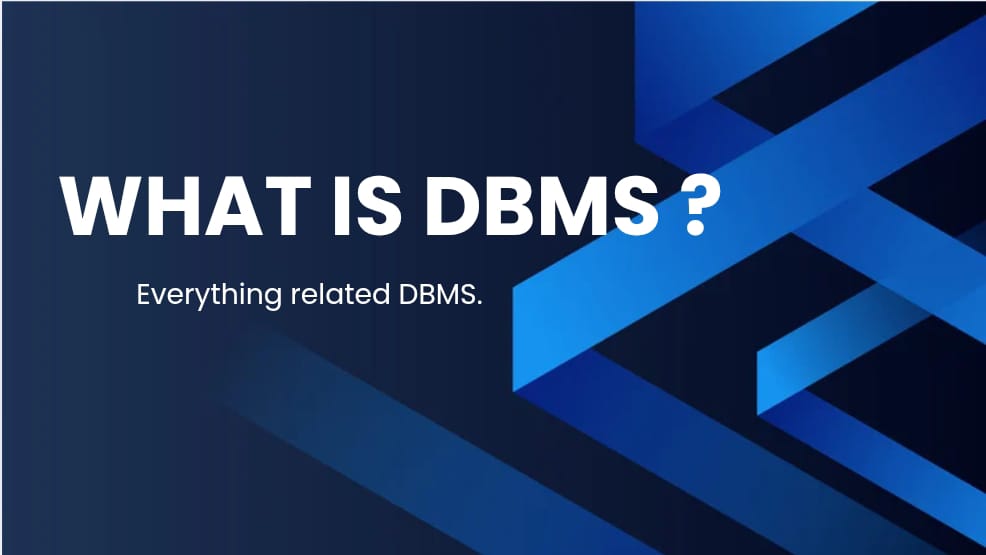Database Management System (DBMS): A Comprehensive Overview
Discover how Database Management Systems (DBMS) transform chaotic data into organized gold! This ultimate guide reveals how top companies leverage DBMS for security, speed and scalability.
A DBMS is allow to store data safe and deal with the large data. It acts as an intermediary between the database and the end-users or applications, ensuring data is organized, secure, and accessible. DBMS is a cornerstone of modern data management, playing a vital role in industries ranging from finance and healthcare to e-commerce and education. This article explores the introduction to DBMS, its purpose, types, resources for studying DBMS, how it manages data, handles large datasets, and its applications.
Introduction to DBMS
A DBMS works with database. It provides a structured framework for storing and organizing data, making it easier to access, update, and analyze. A databas
e is a collection of related data, and the DBMS ensures that this data is stored in a structured format, such as tables, graphs, or documents, depending on the type of DBMS.
 For More Information – Link
For More Information – Link
Key Features of DBMS:
- Data Security: Protects data from unauthorized access.
- Concurrent Data Control: More than one user can access at a time without conflict.
- Data Recovery and Data backup: The data saved can be recovery form the Database .
Why DBMS is Used
DBMS is widely used because it addresses the limitations of traditional file-based data storage systems. Here are the key reasons why DBMS is essential:
- Efficient Data Management:
- DBMS stores data in a specific format so that it is easier to restore and backup data .
- Example: A hospital uses a DBMS to manage patient records, ensuring quick access to medical history.
- Data Security:
- DBMS make data encrypt so that no other can see without permission of actual user.
- Example: Banks use DBMS to secure customer financial data.
- Data Consistency:
- DBMS ensures that the data is in consistent form in the Database.
- Example: In an e-commerce platform, DBMS ensures that product stock levels are updated consistently across all transactions.
- Concurrency Control:
- DBMS ensures that many user can deal with the database at the same time without facing any problem.
- Example: An airline reservation system uses DBMS to handle bookings from multiple users at the same time.
- Data Recovery:
- DBMS provides tools for backup and recovery, minimizing data loss in case of system failures.
- Example: A company uses DBMS to recover lost data after a server crash.
- Scalability:
- Example: Social media platforms like Facebook use DBMS to manage billions of user interactions daily.
Types of DBMS
DBMS can be categorized based on their architecture and data models. The main types include:
- Relational DBMS (RDBMS):
- Data in (rows and columns) format in table.
- Example: MySQL, Oracle, PostgreSQL.
- Hierarchical DBMS:
- It follow the tree structure as parent and child relation.
- Example: IBM Information Management System (IMS).
- Network DBMS:
- It uses graph to represent data .
- Example: Integrated Data Store (IDS).
- Object-Oriented DBMS (OODBMS):
- It stores data is in Object form .
- Example: MongoDB, db4o.
- NoSQL DBMS:
- Designed for unstructured or semi-structured data, offering high scalability.
- Example: Cassandra, Redis.
- Distributed DBMS:
- Manages data across multiple locations, ensuring consistency and availability.
- Example: Google Spanner.
- Cloud DBMS:
- Hosted on cloud platforms, offering scalability and accessibility.
- Example: Amazon RDS, Microsoft Azure SQL Database.
Resources for Studying DBMS
To learn DBMS effectively, you need access to the following resources:
- Books:
- “Database System Concepts” by Abraham Silberschatz.
- Tutorials and Documentation:
- W3Schools SQL Tutorial.
- Official documentation for MySQL, PostgreSQL, and MongoDB.
- Practice Platforms:
- LeetCode, HackerRank, and SQLZoo for practicing SQL queries.
How DBMS Helps To Keep Data Safe?
DBMS ensures data is stored and managed efficiently through the following mechanisms:
- Data Organization:
- Data is stored in structured formats like tables, making it easy to retrieve and update.
- Example: A library management system uses DBMS to organize book records.
- Data Integrity:
- Data Security:
- Example: A healthcare database restricts access to patient records based on user roles.
- Backup and Recovery:
- DBMS automatically backs up data and provides recovery options in case of failures.
- Example: A financial institution uses DBMS to recover transaction data after a system crash.
How DBMS Deals with Huge Data ?
DBMS works with huge data :
- Indexing:
- DBMS uses indexes to speed up data retrieval.
- Example: An e-commerce platform uses indexing to quickly search for products.
- Partitioning:
- Large datasets are divided into smaller, manageable parts.
- Example: A social media platform partitions user data by region.
- Distributed Databases:
- Data is distributed on multiple servers.
- Example: Google uses distributed databases to manage search data.
- In-Memory Processing:
- DBMS stores frequently accessed data in memory for faster retrieval.
- Example: Real-time analytics platforms use in-memory processing for quick insights.
- Parallel Processing:
- DBMS processes multiple queries simultaneously to handle large workloads.
- Example: Financial institutions use parallel processing to analyze transaction data.
Applications of DBMS
- Banking and Finance:
- Manages customer accounts, transactions, and loans.
- Example: Banks use DBMS to process millions of transactions daily.
- Healthcare:
- Stores and manages patient records, medical history, and appointments.
- Example: Hospitals use DBMS to track patient treatments.
- E-Commerce:
- Manages product catalogs, customer orders, and inventory.
- Example: Amazon uses DBMS to handle its vast product database.
- Education:
- Stores student records, course details, and exam results.
- Example: Universities use DBMS to manage student data.
- Social Media:
- Handles user profiles, posts, and interactions.
- Example: Facebook uses DBMS to manage billions of user accounts.
- Telecommunications:
- Manages call records, customer data, and network usage.
- Example: Telecom companies use DBMS to track call details.
- Transportation:
- Manages flight schedules, ticket bookings, and passenger data.
- Example: Airlines use DBMS to handle reservations.
Conclusion
A Database Management System (DBMS) is an indispensable tool for managing data in today’s data-driven world. It provides a structured and efficient way to store, retrieve, and manipulate data while ensuring security, integrity, and scalability. With various types of DBMS available, organizations can choose the one that best suits their needs. By leveraging DBMS, businesses can improve data management, enhance decision-making, and achieve their goals more effectively. Whether it’s handling large datasets or ensuring data security, DBMS continues to play a critical role in modern applications across industries.










